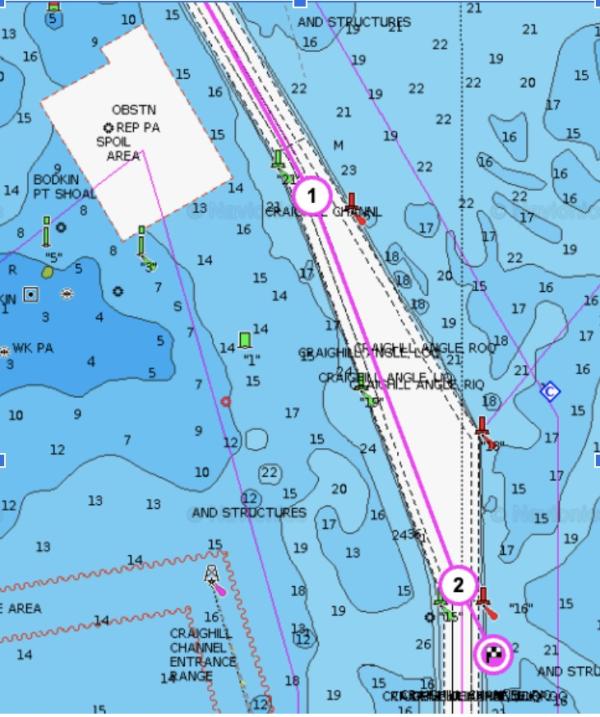No Time for Smartphones
“Safety Moments, presented at CCA Stations and Posts”
By Chuck Hawley, San Francisco Station, May 2023
In March of 2022, a fully-loaded container ship named the Ever Forward ran aground 14 miles from the start of its journey in Baltimore Harbor. On watch were four people on the bridge including a Maryland State Pilot, the Third Officer, an Able Bodied Seaman, and a Deck Cadet. There were no mechanical issues with the ship, visibility 10 miles, winds were light, the Pilot had his Portable Pilot Unit to refer to in addition to all of the navigational devices that were part of the ship, and no one on the bridge was impaired by drugs or alcohol.
So what the heck happened? While the Ever Forward is not the largest container ship around, it is nearly 1100’ long with a beam of almost 160’. This makes it far too large to pass through the original Panama Canal locks, and barely able to squeeze through the new, wider locks. She also drew 42.5’, which becomes more relevant as this is a story of her grounding in the Chesapeake Bay. And she had the ability to carry 12,000 TEU, or twenty foot equivalents/20’ containers or 6,000 40’ containers.
Under the command of the Pilot, Ever Forward departed the Baltimore container port around 1812 on March 13, 2022. There was an issue with the line handlers at the port, which slightly delayed the vessel’s departure, and which bothered the Pilot. The ship proceeded out of the harbor, and at 1903 when it was in the vicinity of Sparrow Point, the Pilot placed a phone call which lasted 55 minutes. The Pilot also sent a text, and made several shorter phone calls.
Here is a brief recap of the 20 minutes following the conclusion of the phone call
2000 The Pilot called for full ahead and the bridge team complied.
2010 The pilot called for a course of 161 deg T, as the ship channel began to turn south towards the south Chesapeake.
2015 The Pilot was again using his phone to send a text message and then (2016) made a phone call that went unanswered.
2017 The Ever Forward arrived at a waypoint (2) where the course needed to be changed to 180 deg T to stay in the channel.
The Pilot was using his Portable Pilot Unit, reviewing a previous passage of the same area. The Third Officer called out that the course was still 161 deg T, and the Pilot confirmed it. The Pilot also noticed that the Bridge Crew were conversing amongst themselves.
2018 The Pilot ordered 20 degrees right rudder, and then 20 seconds later ordered full right rudder. At that point, Ever Forward grounded on the east side of the ship channel in about 24’ of water.
2020 The Pilot tried to use full astern as well as the bow thrusters to free the ship from the mud. Neither was effective.

For the next 35 days, various techniques were used to refloat the ship. Tugboats, dredging, unloading containers, anchored barges, and so forth were used, along with waiting for the highest tides, although the tidal range at that location was only a foot or so. After five weeks, and 200,000 cu yds of dredge spoils, plus the removal of 505 containers, the Ever Forward was refloated without damage, at least to the ship.
Sometimes the size of the ship, or the size of the accident, doesn’t related to the number of actions that, if taken, would keep a similar accident from happening in the future. In this instance, the U.S. Coast Guard came up with only two contributing factors.
In the words of the report, and the recommended actions to avoid similar problems:
1. Failure to maintain situational awareness and attention while navigating.
It is recommended that vessel owners and marine operators develop and implement effective policies outlining when the use of cell phones and other portable electronic devices is appropriate or prohibited.
2. Inadequate bridge resource management.
It is recommended that vessel owners and operators ensure and promote crew awareness of policies regarding the duties and obligations of officers on watch for the safety of the ship, even when a pilot is embarked.
We can all learn from this incident. As skippers of our own boats, or while standing watch on someone else’s, it’s easy to get distracted with navigation chores, updating the log, grabbing another cup of coffee, using the head, and other tasks which take us away from the job at hand: safely piloting the vessel on its intended course.
We can also fall prey to the implied or actual hierarchy on board a vessel. “Geez, s/he is the Watch Captain, I don’t need to point out the vessel behind the sail since s/he obviously knows it’s there.” Or “Geez, I wonder if the navigator knows there’s a shoal that’s on our proposed course?” Sometimes, the cautionary refrain “If you see something, say something.” applies not only to airports and subways, but to well-sailed boats as well. As watch captains or skippers we need to accept the input of crewmembers graciously, even when we’ve been tracking the vessel behind the sail for the last 10 minutes. Encourage feedback for everyone’s sake. Skippers should habitually thank crewmembers for input, not dismiss it.
The Cruising Club of America is a collection of accomplished ocean sailors having extensive boat handling, seamanship, and command experience honed over many years. “Safety Moments” are written by the Club’s Safety Officers from CCA Stations across North America and Bermuda, as well as CCA members at large. They are published by the CCA Safety and Seamanship Committee and are intended to advance seamanship and safety by highlighting new technologies, suggestions for safe operation and reports of maritime disasters around the world.






